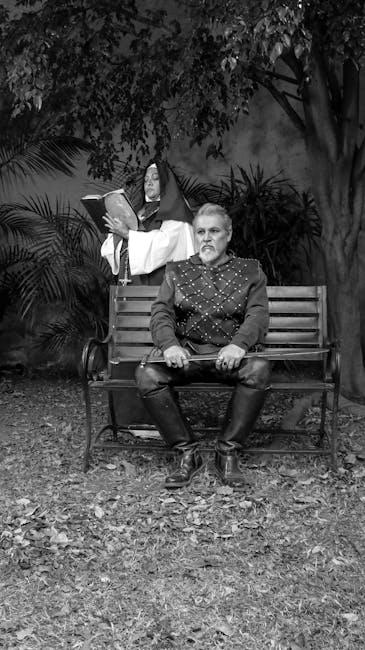In the realm of biographical cinema, actors face the formidable task of embodying real-life figures with authenticity and nuance. This transformative journey demands more than mere imitation; it requires a deep dive into the psyche, mannerisms, and historical context of the individuals they portray. The process of researching and preparing for such roles is both an art and a science, involving meticulous study, creative interpretation, and often, personal transformation. This article explores the intricate methods actors employ to bridge the gap between reality and performance, shedding light on the dedication and craft that bring historical figures to life on the silver screen. Through an analytical lens, we unravel the layers of preparation that underpin some of the most compelling biographical portrayals in film history.
Immersing in Historical Context and Cultural Nuances
When actors delve into biographical roles, immersing themselves in the historical context and cultural nuances is paramount. This process often involves a meticulous examination of the time period in which their character lived, as well as an understanding of the cultural dynamics at play. Actors might spend weeks, if not months, researching the era, studying historical texts, and watching documentaries to accurately portray the essence of their character’s world. By doing so, they not only grasp the events that shaped their character’s life but also the societal norms and expectations that influenced their decisions.
To achieve authenticity, actors frequently engage in several practices:
- Consulting Historians and Experts: Engaging with scholars who specialize in the relevant historical period can provide invaluable insights.
- Visiting Key Locations: Experiencing the actual places where historical events unfolded helps actors absorb the atmosphere and significance of these settings.
- Learning Period-Appropriate Skills: Whether it’s mastering a historical dialect or learning a forgotten craft, acquiring these skills adds layers to their performance.
By embracing these strategies, actors ensure that their portrayals are not only accurate but also deeply resonant, offering audiences a window into the past that feels both genuine and engaging.

Engaging with Primary Sources and Expert Consultations
To accurately portray historical figures, actors often immerse themselves in the world of their subjects through direct engagement with primary sources and consultations with experts. This involves delving into letters, diaries, and autobiographies that provide firsthand insights into the individual’s thoughts and experiences. By examining these materials, actors can capture the nuances of speech and personality that define the character. Such immersion not only aids in understanding the public persona but also reveals the private intricacies of the subject’s life.
In addition to textual resources, actors frequently seek guidance from historians, biographers, and other specialists who possess deep knowledge of the subject. These experts offer critical context and clarity, answering questions about the time period, societal norms, and personal relationships that shaped the individual’s life. Through these collaborations, actors gain a richer understanding, enabling them to deliver performances that are both authentic and compelling.

Mastering Physical Transformation and Vocal Precision
Actors often embark on a journey of meticulous study to embody the essence of a real-life character. This involves an intensive exploration of both physical transformation and vocal precision. The physical aspect can include significant changes in weight, adopting a particular posture, or even learning new skills to match the historical figure’s lifestyle. For instance, some actors may undergo rigorous training regimes, while others might use prosthetics or makeup to capture the character’s unique appearance.
Achieving vocal accuracy is equally crucial, as it adds authenticity to the portrayal. Actors might engage in hours of listening to recordings or watching footage to grasp the character’s accent, tone, and speech patterns. Techniques such as working with dialect coaches or using voice modulation exercises are common. Key methods include:
- Listening and Imitation: Repeatedly listening to the subject’s voice to mimic intonation and rhythm.
- Phonetic Training: Studying the specific phonetic characteristics of the subject’s speech.
- Dialogue Practice: Engaging in rehearsals with scripted conversations to refine delivery.
These combined efforts allow actors to not only replicate but inhabit their roles, delivering performances that resonate with authenticity and respect for the real-life figures they portray.
 Authenticity with Creative Interpretation”>
Authenticity with Creative Interpretation”>
Balancing Emotional Authenticity with Creative Interpretation
Actors often face the challenging task of portraying real-life figures with both sincerity and artistic flair. Striking a balance between staying true to the subject’s genuine emotions and adding a touch of creative interpretation is crucial. This process involves extensive research, where actors immerse themselves in historical context, personal letters, interviews, and even physical mannerisms. Such depth allows them to capture the essence of the person while infusing their own artistic perspective.
To achieve this balance, actors might:
- Consult with historians or experts to ensure accuracy in representation.
- Engage in method acting techniques to deeply connect with the character’s emotional landscape.
- Collaborate with directors and writers to explore nuanced portrayals that respect the truth while enhancing storytelling.
Ultimately, the goal is to create a performance that resonates with audiences, offering an authentic glimpse into the life of the individual while showcasing the actor’s unique interpretive skills.

